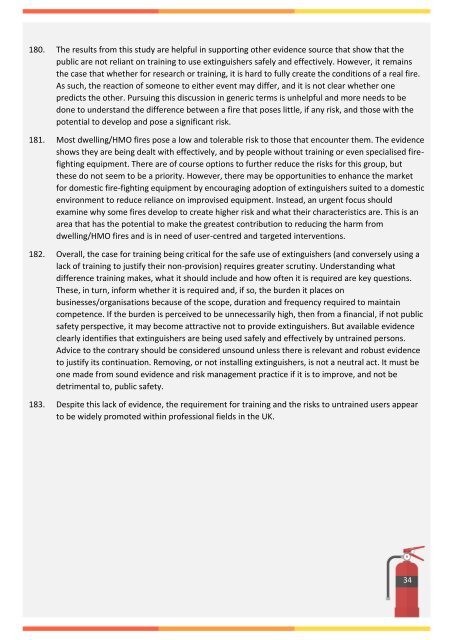An evaluation of the role of fire extinguishers
A report considering the role of a fire extinguisher in human terms identifying the gap between policy assumptions and the evidence from real fires. It considers the implications arising from this and makes a number of recommendations to create an evidence base and enhance current fire safety policies/advice.
A report considering the role of a fire extinguisher in human terms identifying the gap between policy assumptions and the evidence from real fires. It considers the implications arising from this and makes a number of recommendations to create an evidence base and enhance current fire safety policies/advice.
Create successful ePaper yourself
Turn your PDF publications into a flip-book with our unique Google optimized e-Paper software.
180. The results from this study are helpful in supporting o<strong>the</strong>r evidence source that show that <strong>the</strong><br />
public are not reliant on training to use <strong>extinguishers</strong> safely and effectively. However, it remains<br />
<strong>the</strong> case that whe<strong>the</strong>r for research or training, it is hard to fully create <strong>the</strong> conditions <strong>of</strong> a real <strong>fire</strong>.<br />
As such, <strong>the</strong> reaction <strong>of</strong> someone to ei<strong>the</strong>r event may differ, and it is not clear whe<strong>the</strong>r one<br />
predicts <strong>the</strong> o<strong>the</strong>r. Pursuing this discussion in generic terms is unhelpful and more needs to be<br />
done to understand <strong>the</strong> difference between a <strong>fire</strong> that poses little, if any risk, and those with <strong>the</strong><br />
potential to develop and pose a significant risk.<br />
181. Most dwelling/HMO <strong>fire</strong>s pose a low and tolerable risk to those that encounter <strong>the</strong>m. The evidence<br />
shows <strong>the</strong>y are being dealt with effectively, and by people without training or even specialised <strong>fire</strong>fighting<br />
equipment. There are <strong>of</strong> course options to fur<strong>the</strong>r reduce <strong>the</strong> risks for this group, but<br />
<strong>the</strong>se do not seem to be a priority. However, <strong>the</strong>re may be opportunities to enhance <strong>the</strong> market<br />
for domestic <strong>fire</strong>-fighting equipment by encouraging adoption <strong>of</strong> <strong>extinguishers</strong> suited to a domestic<br />
environment to reduce reliance on improvised equipment. Instead, an urgent focus should<br />
examine why some <strong>fire</strong>s develop to create higher risk and what <strong>the</strong>ir characteristics are. This is an<br />
area that has <strong>the</strong> potential to make <strong>the</strong> greatest contribution to reducing <strong>the</strong> harm from<br />
dwelling/HMO <strong>fire</strong>s and is in need <strong>of</strong> user-centred and targeted interventions.<br />
182. Overall, <strong>the</strong> case for training being critical for <strong>the</strong> safe use <strong>of</strong> <strong>extinguishers</strong> (and conversely using a<br />
lack <strong>of</strong> training to justify <strong>the</strong>ir non-provision) requires greater scrutiny. Understanding what<br />
difference training makes, what it should include and how <strong>of</strong>ten it is required are key questions.<br />
These, in turn, inform whe<strong>the</strong>r it is required and, if so, <strong>the</strong> burden it places on<br />
businesses/organisations because <strong>of</strong> <strong>the</strong> scope, duration and frequency required to maintain<br />
competence. If <strong>the</strong> burden is perceived to be unnecessarily high, <strong>the</strong>n from a financial, if not public<br />
safety perspective, it may become attractive not to provide <strong>extinguishers</strong>. But available evidence<br />
clearly identifies that <strong>extinguishers</strong> are being used safely and effectively by untrained persons.<br />
Advice to <strong>the</strong> contrary should be considered unsound unless <strong>the</strong>re is relevant and robust evidence<br />
to justify its continuation. Removing, or not installing <strong>extinguishers</strong>, is not a neutral act. It must be<br />
one made from sound evidence and risk management practice if it is to improve, and not be<br />
detrimental to, public safety.<br />
183. Despite this lack <strong>of</strong> evidence, <strong>the</strong> requirement for training and <strong>the</strong> risks to untrained users appear<br />
to be widely promoted within pr<strong>of</strong>essional fields in <strong>the</strong> UK.<br />
34<br />
2




